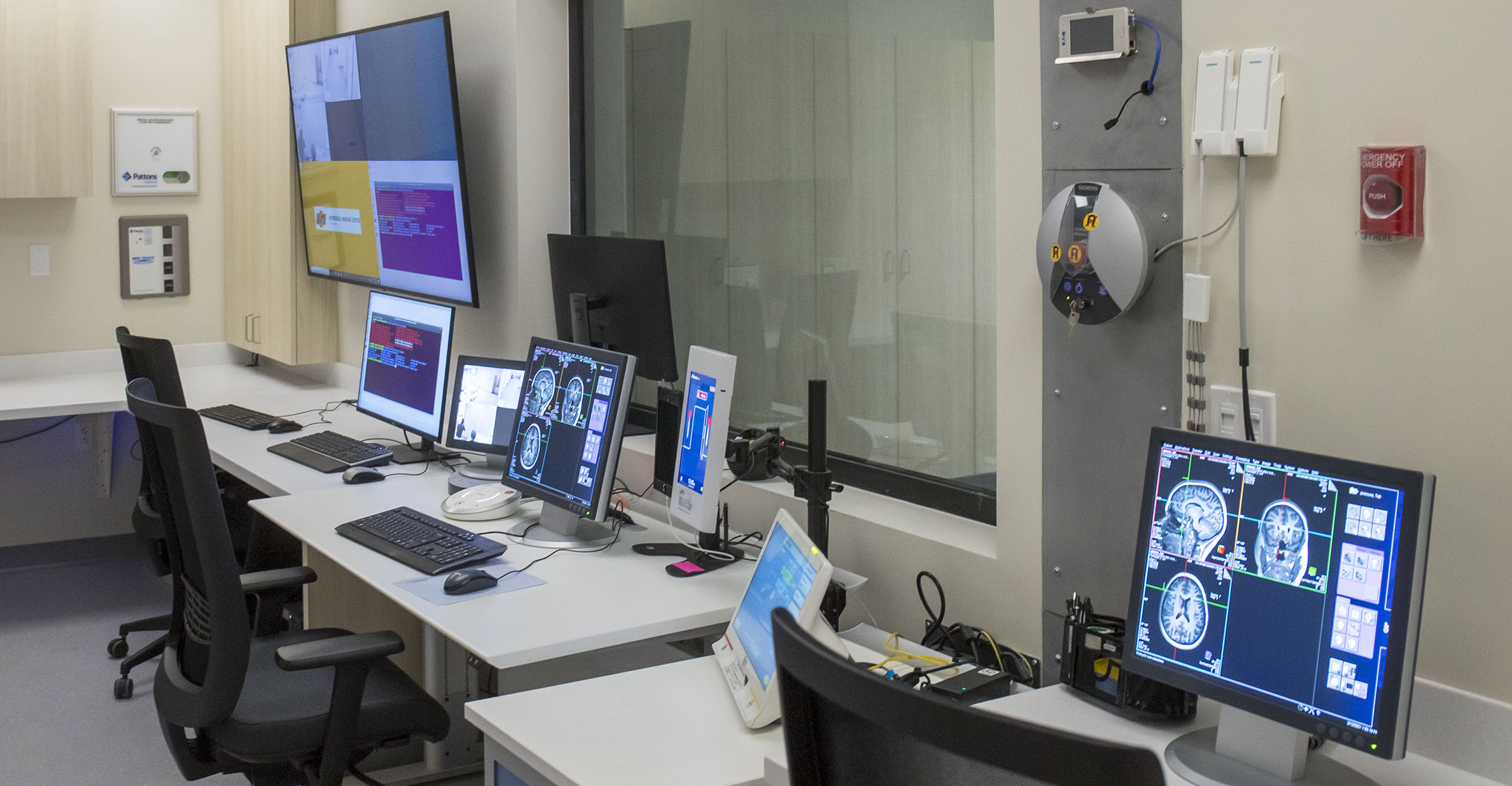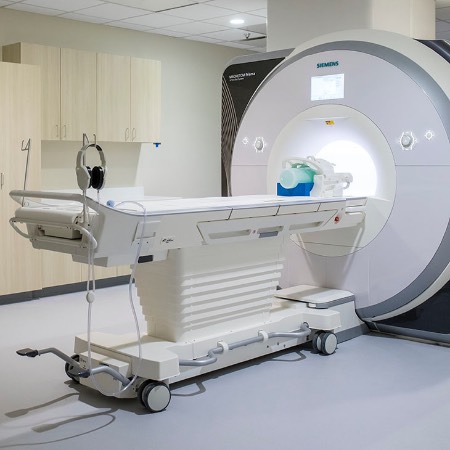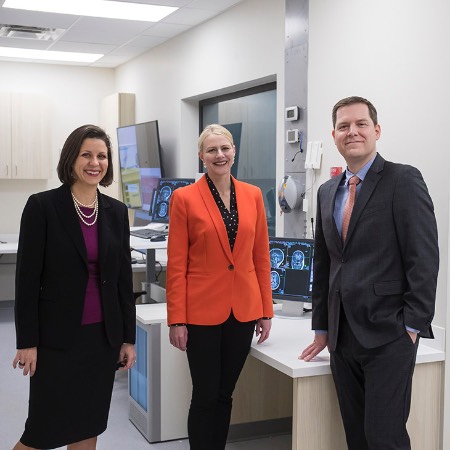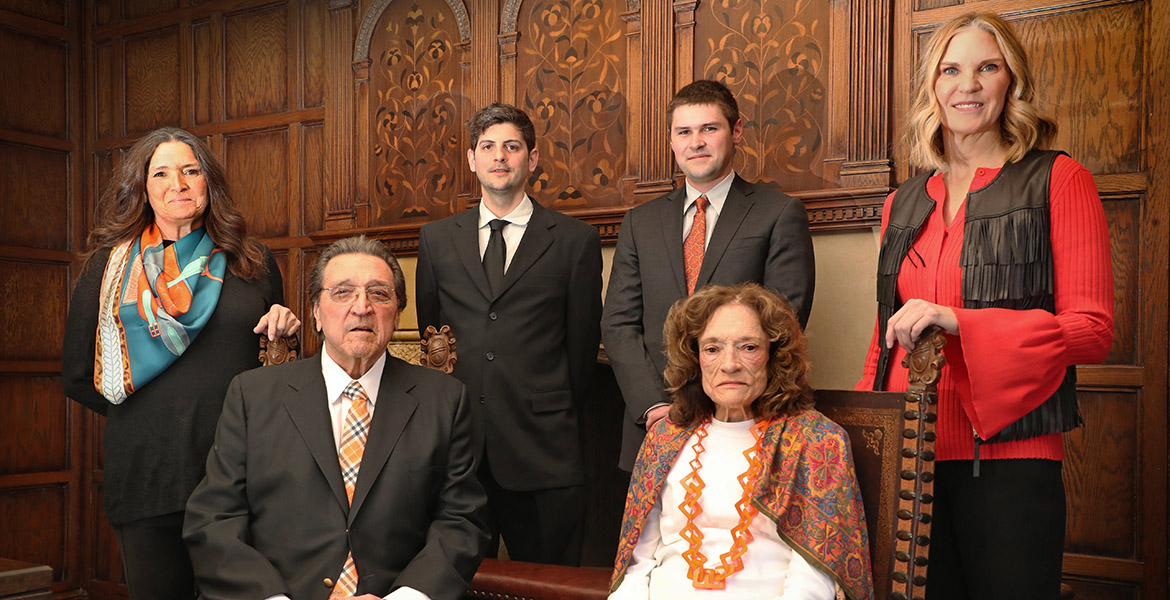
Hardesty Center for Clinical Research and Neuroscience is finding answers to combat addictive behaviors
Wednesday, April 28, 2021
Media Contact: Mack Burke | Editorial Coordinator | 405-744-5540 | editor@okstate.edu
Family foundation's gift helps build hope
Building is in career entrepreneur Roger Hardesty’s DNA. So is his family’s commitment to bettering the lives of Oklahomans. When these drives align, a unique solution for a complex problem comes to life.
Along Riverside Drive in Tulsa, OSU Medicine has transformed an aged facility into one of the country’s finest research centers. The new Hardesty Center for Clinical Research and Neuroscience, spurred by a $2 million gift from The Hardesty Family Foundation, equipped with space for clinical trials and home to the most advanced MRI system in the state, is poised to lessen the impact addictive behavior disorders have on Oklahomans.
“OSU’s medical school, hospital and the National Center for Wellness & Recovery are important to our city because they are all Tulsa-based and serve our local community,” Hardesty said. “By supporting charities and entities from our state, we can expand economic and health multipliers. This helps make our state a thriving, healthy and pleasant place to live, have a family and work.”
The Hardesty Center for Clinical Research and Neuroscience includes the NCWR clinical trials unit, research initiatives and the OSU Medicine Biomedical Imaging Center.
“Results are important,” Hardesty said. “I needed to understand the work that was
going to be done in this facility was true to the mission, which is to understand
addiction, then implement treatment. In advanced research, I know some roads are unexpected
but
still lead to finding the right solutions. I wanted to make sure that the sights are
always focused on people suffering from addictive behaviors.”
OSU has made a strong commitment to fighting addictive behaviors. From medical education and patient care to cutting-edge research and innovative treatment plans, OSU is at the forefront of the field. With this in mind, Hardesty knew he found the right partners with OSU Medicine and NCWR and their visionary leader, OSU Center for Health Sciences President Dr. Kayse Shrum.
“Dr. Shrum and the leaders of the center spoke so passionately about the individuals who need transformative treatment options and what advanced treatment solutions could mean to end many of the societal challenges people suffering addictive behaviors face that I was encouraged and excited about the opportunity to be a part of this,” Hardesty said.
The Hardesty Center is built upon interdisciplinary approaches and collaboration. These values are the bedrock that supports the facility.
“We are deeply indebted to Roger and the Hardesty family for this magnanimous gift, which will allow us to develop personalized, evidence-based therapies for patients suffering from addiction,” Shrum said. “As the national leader in addiction research, OSU Medicine aims to unlock the mystery of addiction through groundbreaking biomedical and clinical research.”
Teamwork
To unlock these mysteries of addictive behaviors, collaboration is key.
“[My wife] Donna and I know that addiction can limit and destroy the potential of individuals who otherwise would lead productive and fulfilling lives, so better understanding causes of addiction and developing tangible treatment solutions is critical to Tulsa’s growth and improved quality of life for its residents,” Hardesty said. “By having OSU’s medical school, hospital, and now NCWR, Tulsans can directly benefit from the collaborative work being done at each of these institutions like never before and take the solutions across the globe.”
Two key collaborators working to unlock answers at the new center are NCWR population and clinical research executive director Julie M. Croff, Ph.D., MPH, and NCWR director of biomedical imaging Kyle Simmons, Ph.D.
“The Hardesty Center is built upon interdisciplinary approaches and collaboration. These values are the bedrock that supports the facility,” Croff said. “Our team members include clinicians, neuroscientists, family scientists, trauma scientists, psychologists and a public health team working in communities. The collaborative values of our team and the center ensure a number of partnerships that will move the field of addiction science forward.”


NCWR’s involvement in the prestigious National Institutes of Health-funded HEALthy
Brain and Child Development study, is leading Croff and others to explore the impact
of early opioid exposure on infant and child development, among other initiatives.
With enhanced research techniques made possible by the OSU Medicine Biomedical Imaging
Center, teams
at the Hardesty Center will examine neural correlates of addiction and how that can
lead to new recovery strategies.
“Our work promises hope and change — hope for a better version of the future and the tenacity to address the changes that need to be put into place,” Croff added. “Our teams are builders, and we are here to build a better and brighter future. The tools at the Hardesty Center allow us to determine approaches to prevention and treatment more quickly. Our integration with clinical services means we can translate the science to action, with the help of our advocacy team, who ensure that commercial and state insurance agencies see the benefit of our approaches.”
It's Personal
The saying “It’s not personal, it’s business” doesn’t apply there. The final key to this partnership is personal.
“Like thousands of other families in Oklahoma, our family has been personally touched by addiction. We all know someone who is battling this terrible brain disease whether it’s our loved ones, neighbors or co-workers,” said Michelle Hardesty, executive director of the Hardesty Family Foundation. “Addiction does not discriminate. It can happen to anyone at any age. We feel honored to play a small part in giving Oklahoma families hope for a better, addiction-free tomorrow.”
A strong connection to OSU is also key for the Hardestys. Roger and Donna’s grandson
Connor Hardesty graduated from OSU in 2019, and
this gift reflects the positive role the university has played in his life.
“What OSU and the NCWR are doing in the fight against addiction will lead to more advanced research techniques and processes that can be implemented in other therapeutic environments and aid in the bigger challenge of pain management solutions,” Connor Hardesty said. “I have been taught by my grandfather and through my time at OSU that building on positive results can transfer to success in other areas. The success we expect to see from the NCWR will be a great source of pride for OSU and Tulsa’s reputation as places for global innovation and advancement.”

The family has also been a strong supporter of the OSU College of Education and Human Sciences through the Roger Hardesty Aviation Collection, Roger Hardesty Lectureship in Aviation Science Fund, Roger Hardesty Scholarship Fund and Roger Hardesty Chair in Aviation Science. The Hardestys have strong Oklahoma roots and a commitment to support the people who live and work in the state.
As a career entrepreneur, Hardesty has founded and operated more than 25 different business ventures including the Quarry Landfill, Mid-Continent Concrete, and BizJet International Sales and Support. The Hardesty Co. began in Tulsa in 1959 building single-family homes. In a short time, the company became the largest single-family construction firm in the area with divisions in nine midwestern states. Hardesty Realty Corp. was established in 1986 in Tulsa as a real estate management and leasing business.
Today, Hardesty is president and CEO of United States Aviation, which provides a wide range of aviation services including private aircraft charter, Black Hawk helicopter air crane operations, and complete fixed- base operator flight services at Tulsa International Airport.
The Hardesty Family Foundation is one of Tulsa’s most active and visible philanthropic foundations with a commitment to the city as a major priority. The Hardesty Center’s creation is made possible through a gift of land in Stillwater that will be sold with the proceeds underwriting the purchase and renovation of the center’s property at 1013 E. 66th Place in Tulsa.
Photos By: Phil Shockley and Matt Barnard
Story By: Aaron Anderson | STATE Magazine
